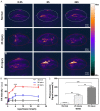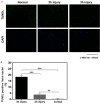Quantitative photoacoustic imaging for early detection of muscle ischemia injury
- PMID: 28559976
- PMCID: PMC5446508
Quantitative photoacoustic imaging for early detection of muscle ischemia injury
Abstract
Acute lower extremity ischemia is a limb-and life-threatening problem. The timing of clinical intervention is critical to achieving optimal outcomes. However, there has been a lack of effective techniques capable of evaluating muscle and limb damage. Microcirculatory injury is the initial pathological change during ischemic muscle injury. Here, we performed photoacoustic imaging (PAI) in real time to quantitatively detect the degree of microcirculatory injury of ischemic muscles in a rat model in which Evans blue (EB), which strongly binds to albumin in blood, was used as a nontoxic molecular PA probe. The right lower hind limbs of Sprague-Dawley (SD) rats were subjected to 2 or 3 hours of tourniquet-induced ischemia. Then, PA imaging of the tibialis anterior (TA) muscles in the anterior compartment was performed for 0-24 h after the release of compression. Twenty-four hours after reperfusion, rats were euthanized and examined for pathology, edema and muscle viability. Imaging at 680 nm on rats revealed that there was significant signal enhancement in the TA muscles of the two injury groups compared to the control group, and the 3-h injury group had significantly higher PA signal intensity than the 2-h injury group at each time point. Histopathology results obtained from both the normal and the damaged muscles correlated well with the PAI findings. In conclusion, PA imaging is a promising modality for quantitatively detecting limb and muscle ischemic injury and may pave the road for further clinical application.
Keywords: Muscle; extremity; ischemic injury; microcirculatory injury; photoacoustic imaging.
Conflict of interest statement
None.
Figures






Similar articles
-
Effect of fluid resuscitation on acute skeletal muscle ischemia-reperfusion injury after hemorrhagic shock in rats.J Am Coll Surg. 2006 Jun;202(6):888-96. doi: 10.1016/j.jamcollsurg.2006.03.003. J Am Coll Surg. 2006. PMID: 16735202
-
Can Cytoprotective Cobalt Protoporphyrin Protect Skeletal Muscle and Muscle-derived Stem Cells From Ischemic Injury?Clin Orthop Relat Res. 2015 Sep;473(9):2908-19. doi: 10.1007/s11999-015-4332-8. Clin Orthop Relat Res. 2015. PMID: 26070773 Free PMC article.
-
Muscle fiber viability, a novel method for the fast detection of ischemic muscle injury in rats.PLoS One. 2014 Jan 13;9(1):e84783. doi: 10.1371/journal.pone.0084783. eCollection 2014. PLoS One. 2014. PMID: 24454750 Free PMC article.
-
Photoacoustic imaging in monitoring of compartmental syndrome in rat extremities.Appl Opt. 2021 Apr 1;60(10):2912-2918. doi: 10.1364/AO.418517. Appl Opt. 2021. PMID: 33798173
-
[Novel findings from an animal tourniquet shock model].Nihon Hoigaku Zasshi. 2003 Sep;57(2):125-34. Nihon Hoigaku Zasshi. 2003. PMID: 14574964 Review. Japanese.
Cited by
-
Methods of ex vivo analysis of tissue status in vascularized composite allografts.J Transl Med. 2023 Sep 8;21(1):609. doi: 10.1186/s12967-023-04379-x. J Transl Med. 2023. PMID: 37684651 Free PMC article. Review.
-
Gold Nanorod-Loaded Nano-Contrast Agent with Composite Shell-Core Structure for Ultrasonic/Photothermal Imaging-Guided Therapy in Ischemic Muscle Disorders.Int J Nanomedicine. 2024 May 8;19:4121-4136. doi: 10.2147/IJN.S445990. eCollection 2024. Int J Nanomedicine. 2024. PMID: 38736655 Free PMC article.
-
Photoacoustic tomography for human musculoskeletal imaging and inflammatory arthritis detection.Photoacoustics. 2018 Jul 27;12:82-89. doi: 10.1016/j.pacs.2018.07.004. eCollection 2018 Dec. Photoacoustics. 2018. PMID: 30596016 Free PMC article. Review.
-
Looking deep inside tissue with photoacoustic molecular probes: a review.J Biomed Opt. 2022 Jul;27(7):070901. doi: 10.1117/1.JBO.27.7.070901. Epub 2022 Jul 22. J Biomed Opt. 2022. PMID: 36451698 Free PMC article. Review.
-
Functional photoacoustic imaging: from nano- and micro- to macro-scale.Nano Converg. 2023 Jun 19;10(1):29. doi: 10.1186/s40580-023-00377-3. Nano Converg. 2023. PMID: 37335405 Free PMC article. Review.
References
-
- Malinoski DJ, Slater MS, Mullins RJ. Crush injury and rhabdomyolysis. Crit Care Clin. 2004;20:171–192. - PubMed
-
- Walker TG. Acute limb ischemia. Tech Vasc Interv Radiol. 2009;12:117–129. - PubMed
-
- Henke PK. Contemporary management of acute limb ischemia: factors associated with amputation and in-hospital mortality. Semin Vasc Surg. 2009;22:34–40. - PubMed
-
- Aftabuddin M, Islam N, Jafar MA, Haque I. The status of lower-limb amputation in Bangladesh: a 6-year review. Surg Today. 1997;27:130–134. - PubMed
-
- Nakayama T, Fujita M, Ishihara M, Ishihara M, Ogata S, Yamamoto Y, Shimizu M, Maehara T, Kanatani Y, Tachibana S. Improved survival rate by temperature control at compression sites in rat model of crush syndrome. J Surg Res. 2014;188:250–259. - PubMed
LinkOut - more resources
Full Text Sources
Other Literature Sources
